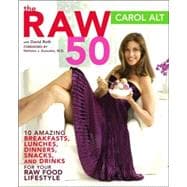
| Foreword | p. 6 |
| Introduction | p. 15 |
| The Raw 50 Staples | p. 22 |
| Outfitting the Raw Kitchen | p. 24 |
| Your Raw Staples Shopping List | p. 26 |
| Vegan or Not? | p. 40 |
| Sprouting and Germinating | p. 41 |
| 10 Raw Breakfasts | p. 44 |
| Testimonial: Christine Alt | p. 56 |
| 10 Raw Lunches | p. 60 |
| Testimonial: Penni Shelton | p. 106 |
| 10 Raw Dinners | p. 108 |
| Testimonial: Ginger Tansen | p. 150 |
| 10 Raw Drinks | p. 152 |
| Testimonial: Donald Good | p. 164 |
| 10 Raw Snacks | p. 168 |
| Testimonial: Glen Moses | p. 182 |
| Testimonial: Amanda Sager | p. 183 |
| Recipe Credits | p. 185 |
| Acknowledgments | p. 186 |
| Index | p. 188 |
| Table of Contents provided by Ingram. All Rights Reserved. |
The New copy of this book will include any supplemental materials advertised. Please check the title of the book to determine if it should include any access cards, study guides, lab manuals, CDs, etc.
The Used, Rental and eBook copies of this book are not guaranteed to include any supplemental materials. Typically, only the book itself is included. This is true even if the title states it includes any access cards, study guides, lab manuals, CDs, etc.
Excerpted from The Raw 50: 10 Amazing Breakfasts, Lunches, Dinners, Snacks, and Drinks for Your Raw Food Lifestyle by Carol Alt, David Roth
All rights reserved by the original copyright owners. Excerpts are provided for display purposes only and may not be reproduced, reprinted or distributed without the written permission of the publisher.